Building Categorization Strategy Guidance in the Historic Area Renovation Process
Abstract
1. Introduction
2. Literature Review
2.1. Historic Area Renovation
2.2. Traditional Historic Area Renovation in China
2.3. International New Trend of Historic Area Renovation
3. Methodology
3.1. Introduce a Dynamic Evaluation Model
3.2. Deepening the Application of the Dynamic Evaluation Model
4. Case Study
4.1. Project Background
4.2. Classification before Renovation
4.3. Classification during the Renovation Process
4.4. Classification of the Areas
5. Categorization Strategy Guidance
5.1. Guidance for Buildings before Renovation
5.2. Guidance for Buildings during the Renovation Process
5.3. Categorization Strategy for the Whole Area
6. Discussion
7. Conclusions
Author Contributions
Funding
Institutional Review Board Statement
Informed Consent Statement
Data Availability Statement
Acknowledgments
Conflicts of Interest
Appendix A
| Economy of construction dimension | ||||||||||||
| Historical buildings | Standard | —— | —— | —— | —— | —— | Modern construction | Traditional construction including wood structure, brick and wood structure. | ||||
| Collapse | Unsteady | Some problem | Average | Steady | ||||||||
| Score | —— | —— | —— | —— | —— | 0 | 1 | 2 | 3 | 4 | 5 | |
| Legend color | —— | —— | —— | —— | —— |  |  |  |  |  |  | |
| Other buildings | Standard | Modern construction including Brick -concrete structure, steel concrete structure. | —— | Traditional construction including wood structure, brick and wood structure. | ||||||||
| Steady | Average | Some problem | Unsteady | Collapse | —— | Collapse | Unsteady | Some problem | Average | Steady | ||
| Score | −5 | −4 | −3 | −2 | −1 | —— | 1 | 2 | 3 | 4 | 5 | |
| Legend color |  |  |  |  |  | —— |  |  |  |  |  | |
| Cultural of form dimension | ||||||||||||
| Historical buildings | Standard | —— | —— | —— | —— | —— | Modern Form | The degree of fit between trditional building form with “Target Historical Style Di-agram” | ||||
| Not fit | Low degree | Average degree | High degree | Totally fit | ||||||||
| Score | —— | —— | —— | —— | —— | 0 | 1 | 2 | 3 | 4 | 5 | |
| Legend color | —— | —— | —— | —— | —— |  |  |  |  |  |  | |
| Other buildings | Standard | Modern building form conveys suitable historical information | —— | The degree of fit between trditional building form with “Target Historical Style Di-agram” | ||||||||
| Most | More | General | Less | Least | —— | Not fit | Low degree | Average degree | High degree | Totally fit | ||
| Score | −5 | −4 | −3 | −2 | −1 | —— | 1 | 2 | 3 | 4 | 5 | |
| Legend color |  |  |  |  |  | —— |  |  |  |  |  | |
| Social of benefit dimension | ||||||||||||
| Historical buildings | Standard | Internal functions | Empty/ Industrial/Garbage treatment/public toilet | External functions | ||||||||
| —— | Educational building | Administrative office | Medical building | Local Residence | Business office | Catering bar/Entertainment Leisure | Commercial retail/creative office | Hotel | Public service building/ Cultural commenmorative | |||
| Score | —— | −4 | −3 | −2 | −1 | 0 | 1 | 2 | 3 | 4 | 5 | |
| Legend color | —— |  |  |  |  |  |  |  |  |  |  | |
| Other buildings | Standard | Internal functions | Empty | External functions | ||||||||
| Educational building | Administrative office | Medical building | Local Residence | Industrial/Garbage treatment/public toilet | Business office | creative office | Hotel | Catering bar/Entertainment Leisure | Public service building/ Cultural commenmorative/ Commercial retail | |||
| Score | −5 | −4 | —— | −2 | −1 | 0 | 1 | 2 | 3 | 4 | 5 | |
| Legend color |  |  | —— |  |  |  |  |  |  |  |  | |
| Five Alleys to Han Xi Street Historic Area | City Central Historic Area | Bell and Drum Tower Historic Area | |
|---|---|---|---|
| X-axis Value | 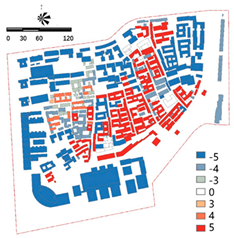 | 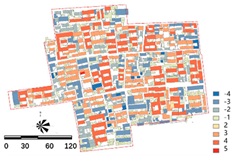 | 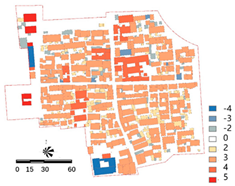 |
| Target Historical Style Diagram | 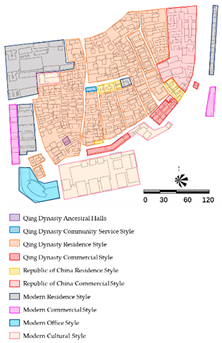 | 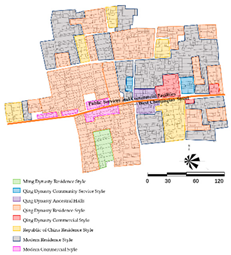 | 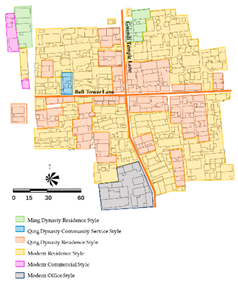 |
| Y-axis Value | 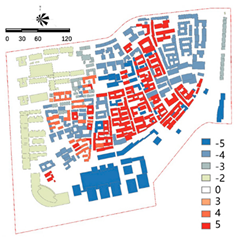 | 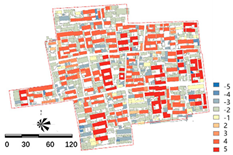 | 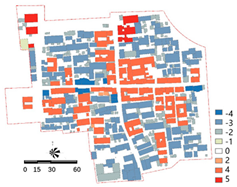 |
| Z-axis Value | 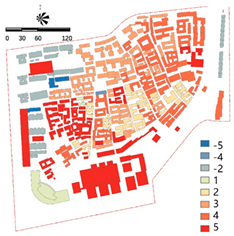 | 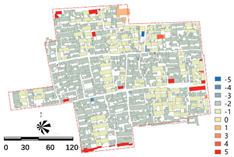 | 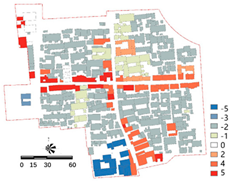 |
Appendix B
| Historical Buildings | Other Buildings | |
|---|---|---|
| Comparison of seven clustering methods | 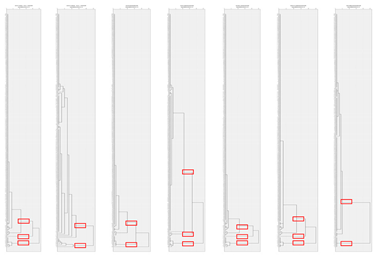 | 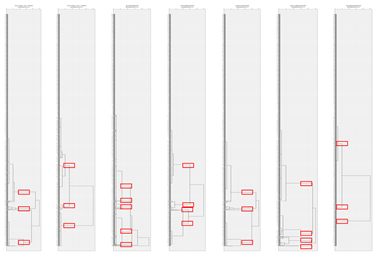 |
| Number of clusters | 3 | 3 |
| Cluster Center | |||
| Cluster Type | 1 | 2 | 3 |
| Structure | 4 | 3 | 2 |
| Form | 5 | 4 | −3 |
| Benefit | −1 | −1 | −1 |
| Number of cases in each cluster | |||
| Cluster | 1 | 153 | |
| 2 | 39 | ||
| 3 | 9 | ||
| Efficient | 201 | ||
| Missing | 0 | ||
| Distance between the cluster centers | |||
| Cluster | 1 | 2 | 3 |
| 1 | 1.382 | 7.737 | |
| 2 | 1.382 | 6.687 | |
| 3 | 7.737 | 6.687 | |
| Cluster Center | |||
| Cluster Type | 1 | 2 | 3 |
| Structure | −1 | −2 | 3 |
| Form | −1 | −2 | 4 |
| Benefit | 5 | −2 | −2 |
| Number of cases in each cluster | |||
| Cluster | 1 | 31 | |
| 2 | 821 | ||
| 3 | 157 | ||
| Efficient | 1009 | ||
| Missing | 0 | ||
| Distance between the cluster centers | |||
| Cluster | 1 | 2 | 3 |
| 1 | 6.972 | 9.550 | |
| 2 | 6.972 | 7.476 | |
| 3 | 9.550 | 7.476 | |
| Historical Buildings | Other Buildings | |
|---|---|---|
| Comparison of seven clustering methods | 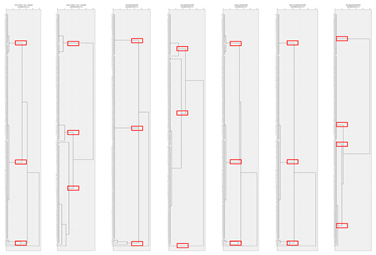 | 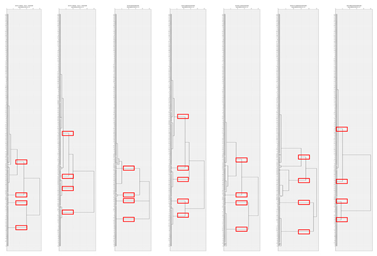 |
| Number of clusters | 3 | 4 |
| Cluster Center | |||
| Cluster Type | 1 | 2 | 3 |
| Structure | 5 | 5 | 3 |
| Form | 5 | 5 | 5 |
| Benefit | −4 | 2 | 4 |
| Number of cases in each cluster | |||
| Cluster | 1 | 1 | |
| 2 | 72 | ||
| 3 | 89 | ||
| Efficient | 162 | ||
| Missing | 0 | ||
| Distance between the cluster centers | |||
| Cluster | 1 | 2 | 3 |
| 1 | 6.281 | 8.099 | |
| 2 | 6.281 | 2.339 | |
| 3 | 8.099 | 2.339 | |
| Cluster Center | ||||
| Cluster Type | 1 | 2 | 3 | 4 |
| Structure | −5 | −4 | 5 | −4 |
| Form | −2 | 4 | 3 | −4 |
| Benefit | −2 | 4 | 4 | 4 |
| Number of cases in each cluster | ||||
| Cluster | 1 | 52 | ||
| 2 | 8 | |||
| 3 | 91 | |||
| 4 | 277 | |||
| Efficient | 428 | |||
| Missing | 0 | |||
| Distance between the cluster centers | ||||
| Cluster | 1 | 2 | 3 | 4 |
| 1 | 9.145 | 12.398 | 6.411 | |
| 2 | 9.145 | 9.044 | 8.092 | |
| 3 | 12.398 | 9.044 | 11.427 | |
| 4 | 6.411 | 8.092 | 11.427 | |
| Historical Buildings | Other Buildings | |
|---|---|---|
| Comparison of seven clustering methods | 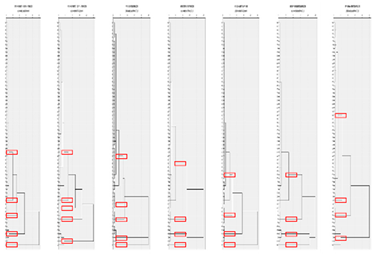 | 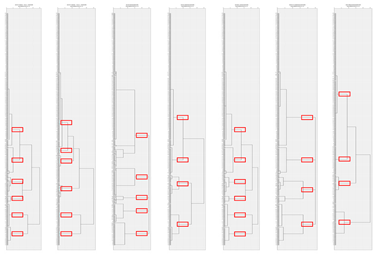 |
| Number of clusters | 4 | 6 |
| Cluster Center | ||||
| Cluster Type | 1 | 2 | 3 | 4 |
| Structure | 4 | 0 | 4 | 0 |
| Form | 4 | 5 | 4 | 0 |
| Benefit | 1 | −1 | −1 | −1 |
| Number of cases in each cluster | ||||
| Cluster | 1 | 13 | ||
| 2 | 5 | |||
| 3 | 42 | |||
| 4 | 1 | |||
| Efficient | 61 | |||
| Missing | 0 | |||
| Distance between the cluster centers | ||||
| Cluster | 1 | 2 | 3 | 4 |
| 1 | 4.527 | 1.964 | 6.239 | |
| 2 | 4.527 | 4.132 | 4.604 | |
| 3 | 1.964 | 4.132 | 5.879 | |
| 4 | 6.239 | 4.604 | 5.879 | |
| Cluster Center | ||||||
| Cluster Type | 1 | 2 | 3 | 4 | 5 | 6 |
| Structure | 3 | 3 | 3 | −2 | −2 | 3 |
| Form | −3 | −3 | 4 | −2 | −2 | 4 |
| Benefit | −2 | 4 | 4 | 4 | −2 | −2 |
| Number of cases in each cluster | ||||||
| Cluster | 1 | 282 | ||||
| 2 | 44 | |||||
| 3 | 39 | |||||
| 4 | 17 | |||||
| 5 | 60 | |||||
| 6 | 49 | |||||
| Efficient | 491 | |||||
| Missing | 0 | |||||
| Distance between the cluster centers | ||||||
| Cluster | 1 | 2 | 3 | 4 | 5 | 6 |
| 1 | 6.179 | 9.141 | 7.874 | 4.816 | 6.403 | |
| 2 | 6.179 | 7.073 | 5.324 | 8.142 | 9.178 | |
| 3 | 9.141 | 7.073 | 7.960 | 10.287 | 6.258 | |
| 4 | 7.874 | 5.324 | 7.960 | 6.260 | 9.897 | |
| 5 | 4.816 | 8.142 | 10.287 | 6.260 | 7.879 | |
| 6 | 6.403 | 9.178 | 6.258 | 9.897 | 7.879 | |
References
- Sun, C.; Zhou, Y.; Han, Y. Automatic generation of architecture facade for historical urban renovation using generative adversarial network. Build. Environ. 2022, 212, 108781. [Google Scholar] [CrossRef]
- Gai, Q.; Li, Z.; Hu, H. Strategies for China’s Historic Districts Regeneration in Responding to Public Health Emergencies. Sustainability 2022, 14, 14020. [Google Scholar] [CrossRef]
- Singh, J.; Singh, J. COVID-19 and its impact on society. Electron. Res. J. Soc. Sci. Humanit. 2020, 2, 5. [Google Scholar]
- Pérez, M.G.R.; Laprise, M.; Rey, E. Fostering sustainable urban renewal at the neighborhood scale with a spatial decision support system. Sustain. Cities Soc. 2018, 38, 440–451. [Google Scholar] [CrossRef]
- Manupati, V.K.; Ramkumar, M.; Samanta, D. A multi-criteria decision making approach for the urban renewal in Southern India. Sustain. Cities Soc. 2018, 42, 471–481. [Google Scholar] [CrossRef]
- Urban Planning Organization Approaches in China. 2006. Available online: https://www.gov.cn/ziliao/flfg/2006-02/15/content_191969.htm (accessed on 4 February 2024).
- Bandarin, F.; van Oers, R. The Historic Urban Landscape: Managing Heritage in an Urban Century, 1st ed.; Wiley: Hoboken, NJ, USA, 2012. [Google Scholar]
- China ICOMOS. Principles for the Conservation of Heritage Sites in China. China ICOMOS. 2002. Available online: https://www.getty.edu/conservation/publications_resources/pdf_publications/pdf/china_prin_1chinese.pdf (accessed on 19 January 2024).
- Ragni, M.; Maurano, A.; Scoppola, F.; Soragni, U.; Baraldi, M.; D’Amico, S.; Mercalli, M.; Banchini, R.; Bellisario, M.G.; Rubino, C.; et al. Linee di Indirizzo per il Miglioramento Dell’efficienza Energetica nel Patrimonio Culturale; Architettura Centri e Nuclei Storici ed Urbani. Ministero dei Beni Culturali: Roma, Italy, 2013; pp. 1–200. Available online: https://certifico.com/component/attachments/download/13558 (accessed on 19 January 2024).
- Charter, K. Principles for Conservation and Restoration of Built Heritage; Marsilio: Venice, Italy, 2000; Available online: http://icomosubih.ba/pdf/medjunarodni_dokumenti/2000%20Krakovska%20povelja.pdf (accessed on 19 January 2024).
- Di Giovine, M.A. The heritage scape: Origins, theoretical interventions, and critical reception of a model for understanding UNESCO’s World Heritage Program. Tour. Rev. 2018, 13, 185–197. [Google Scholar] [CrossRef]
- Al-Sakkaf, A.; Zayed, T.; Bagchi, A. A Review of Definition and Classification of Heritage Buildings and Framework for their Evaluation. In Proceedings of the 2nd International Conference on New Horizons in Green Civil Engineering (NHICE-02), Victoria, BC, Canada, 24–27 August 2020; pp. 1–5. Available online: https://www.researchgate.net/publication/341160581_A_Review_of_Definition_and_Classification_of_Heritage_Buildings_and_Framework_for_their_Evaluation#fullTextFileContent (accessed on 19 January 2024).
- Hewison, R. The Heritage Industry: Britain in a Climate of Decline, 1st ed.; Routledge: London, UK, 1987. [Google Scholar] [CrossRef]
- Bulut, Y.; Atabeyoğlu, Ö. Fountains as urban furniture in historical urban structure and usage culture: Erzurum city case. Build. Environ. 2007, 42, 2432–2438. [Google Scholar] [CrossRef]
- Rodwell, D. Conservation and Sustainability in Historic Cities; Blackwell: Oxford, UK, 2007; p. 59. [Google Scholar]
- Poulios, I. Is Every Heritage Site a ‘Living’ One? Linking Conservation to Communities’ Association with Sites. Hist. Environ. Policy Pract. 2011, 2, 144–156. [Google Scholar] [CrossRef]
- Poulios, I. The Past in the Present: A Living Heritage Approach—Meteora, Greece; Ubiquity Press: London, UK, 2014. [Google Scholar]
- Poulios, I. Discussing Strategy in Heritage Conservation: Living Heritage Approach as an Example of Strategic Innovation. J. Cult. Herit. Manag. Sustain. Dev. 2014, 4, 16–34. [Google Scholar] [CrossRef]
- Poulios, I. Moving Beyond a Values-Based Approach to Heritage Conservation. Conserv. Manag. Archaeol. Sites 2010, 12, 170–185. [Google Scholar] [CrossRef]
- Zancheti, S.M.; Jokilehto, J. Values and urban conservation planning: Some reflections on principles and definitions. J. Archit. Conserv. 1997, 3, 37–51. [Google Scholar] [CrossRef]
- Schávelzon, D. Historic Site and Historic Building Preservation: Overview. In Encyclopedia of Global Archaeology; Smith, C., Ed.; Springer: Berlin/Heidelberg, Germany, 2020; pp. 3385–3388. Available online: https://link.springer.com/referenceworkentry/10.1007/978-3-030-30018-0_1378 (accessed on 19 January 2024).
- Akande, O.K. Factors Influencing Operational Energy Performance and Refurbishment of UK Listed Church Buildings: Towards a Strategic Management Framework. Ph.D. Thesis, Anglia Ruskin University, Cambridge, UK, 2015. [Google Scholar]
- Rong, X.; Li, C. A Brief Analysis of the Improvement of the Law of the People’s Republic of China on the Protection of Cultural Relics. Sci. Soc. Res. 2023, 5, 18–23. [Google Scholar] [CrossRef]
- The Provisional Regulations on the Protection and Management of Cultural Relics. 1961. Available online: https://en.unesco.org/sites/default/files/china_law_1961_chin_orof.pdf (accessed on 8 February 2024).
- The Law of the People’s Republic of China on Protection of Cultural Relics. 1982. Available online: https://english.www.gov.cn/archive/laws_regulations/2014/08/23/content_281474982987444.htm (accessed on 19 January 2024).
- Regulations on the Protection of Famous Historical and Cultural Cities, Towns, and Villages. 1994. Available online: https://www.cecc.gov/resources/legal-provisions/regulation-on-the-protection-of-famous-historic-and-cultural-cities-towns (accessed on 19 January 2024).
- The Temporary Measure on the Conservation and Management of Tunxi Old Street in Huangshan. 1997. Available online: https://www.163.com/dy/article/HS2PLCFK05346KFL.html (accessed on 8 February 2024).
- Jin, X. Strategy and Practice for the Adaptive Renovation to the Multiple Historic Sites of Modern Times. Ph.D. Thesis, Dalian University of Technology, Dalian, China, 2010. [Google Scholar]
- Guidelines for the Preparation of the Protection Planning of Historical and Cultural District in Jiangsu Province. 2008. Available online: https://www.docin.com/p-2439895684.html (accessed on 4 February 2024).
- Guidelines for the Preparation of Conservation Planning for Historic District in Jiangsu Province. Available online: https://www.taodocs.com/p-438816124.html (accessed on 4 February 2024).
- Qiu, B. Situation & Problem of and Counter Measure for the Conservation of the Historical and Cultural Cities in China. China Anc. City 2012, 12, 4–9. [Google Scholar]
- Ruan, Y. Thinking on the Protection of Historical Cultural Heritage. Shanghai Urban Plan. Rev. 2011, 4, 3–6. [Google Scholar]
- Carroon, J.; Moe, R. Sustainable Preservation: Greening Existing Buildings, 1st ed.; Wiley: Hoboken, NJ, USA, 2010. [Google Scholar]
- Onecha, B.; Dotor, A.; Marmolejo-Duarte, C. Beyond Cultural and Historic Values, Sustainability as a New Kind of Value for Historic Buildings. Sustainability 2021, 13, 8248. [Google Scholar] [CrossRef]
- ICOMOS. Heritage and Sustainable Development Goals: Policy Guidance for Heritage and Development Actors; ICOMOS: Paris, France, 2021; Available online: https://openarchive.icomos.org/id/eprint/2453/ (accessed on 19 January 2024).
- UN. Transforming Our World: The 2030 Agenda for Sustainable Development, A/RES/70/1 Resolution. Available online: https://sustainabledevelopment.un.org/content/documents/21252030%20Agenda%20for%20Sustainable%20Development%20web.pdf (accessed on 19 January 2024).
- Roberti, F.; Oberegger, U.F.; Gasparella, A. Calibrating historic building energy models to hourly indoor air and surface temperatures: Methodology and case study. Energy Build. 2015, 108, 236–243. [Google Scholar] [CrossRef]
- Lucchi, E.; Pracchi, V. Efficienza Energetica e Patrimonio Costruito: La Sfida del Miglioramento Delle Prestazioni Nell’edilizia Storica; Ed. Maggioli: Milano, Italy, 2013. [Google Scholar]
- Ma, Z.; Cooper, P.; Daly, D.; Ledo, L. Existing building retrofits: Methodology and state-of-the-art. Energy Build. 2012, 55, 889–902. [Google Scholar] [CrossRef]
- Ward, A.R. Echoes in a Changing Urban Landscape: Memories and Place identity in Durham, North Carolina. Ph.D. Thesis, The University of North Carolina at Chapel Hill, Chapel Hill, NC, USA, 2012. [Google Scholar]
- Aksözen, M.; Hassler, U.; Kohler, N. Reconstitution of the dynamics of an urban building stock. Build. Res. Inf. 2017, 45, 239–258. [Google Scholar] [CrossRef]
- Han, Y.; Qiao, X.; Sun, W.C.; Zhang, L.T. Application of virtual reality GIS in urban planning—An example in Huangdao district. In Proceedings of the 15th International Conference on Geoinformatics, Seattle, WD, USA, 7–9 November 2007; Volume 6754. Part 1–2. [Google Scholar] [CrossRef]
- Baggio, M.; Tinterri, C.; Dalla Mora, T.; Righi, A.; Peron, F.; Romagnoni, P. Sustainability of a historical building renovation design through the application of LEED® rating system. Int. Sci. Conf. Environ. Clim. Technol. (CONECT) 2017, 113, 382–389. [Google Scholar] [CrossRef]
- Vardopoulos, I. Adaptive Reuse for Sustainable Development and Land Use: A Multivariate Linear Regression Analysis Estimating Key Determinants of Public Perceptions. Heritage 2023, 6, 809–828. [Google Scholar] [CrossRef]
- Anelli, D.; Tajani, F. Valorization of cultural heritage and land take reduction: An urban compensation model for the replacement of unsuitable buildings in an Italian UNESCO site. J. Cult. Herit. 2022, 57, 165–172. [Google Scholar] [CrossRef]
- Al-Sakkaf, A.; Zayed, T.; Bagchi, A. A Sustainability Based Framework for Evaluating the Heritage Buildings. IJEOE 2020, 9, 49–73. [Google Scholar] [CrossRef]
- Karimi, F.; Valibeig, N.; Memarian, G.; Kamari, A. Sustainability Rating Systems for Historic Buildings: A Systematic Review. Sustainability 2022, 14, 12448. [Google Scholar] [CrossRef]
- Xia, S.; Liu, B.; Wang, H. Construction of a Sustainability-Based Building Attribute Conservation Assessment Model in Historic Areas. Buildings 2022, 12, 1346. [Google Scholar] [CrossRef]
- The Athens Charter for the Restoration of Historic Monuments—1931 Written on 11 November 2011. Available online: https://www.icomos.org/en/charters-and-texts/179-articles-en-francais/ressources/charters-and-standards/167-the-athens-charter-for-the-restoration-of-historic-monuments (accessed on 19 January 2024).
- Adamus-Matuszyńska, A.; Michnik, J.; Polok, G. A systemic approach to city image building. The case of Katowice city. Sustainability 2019, 11, 4470. [Google Scholar] [CrossRef]
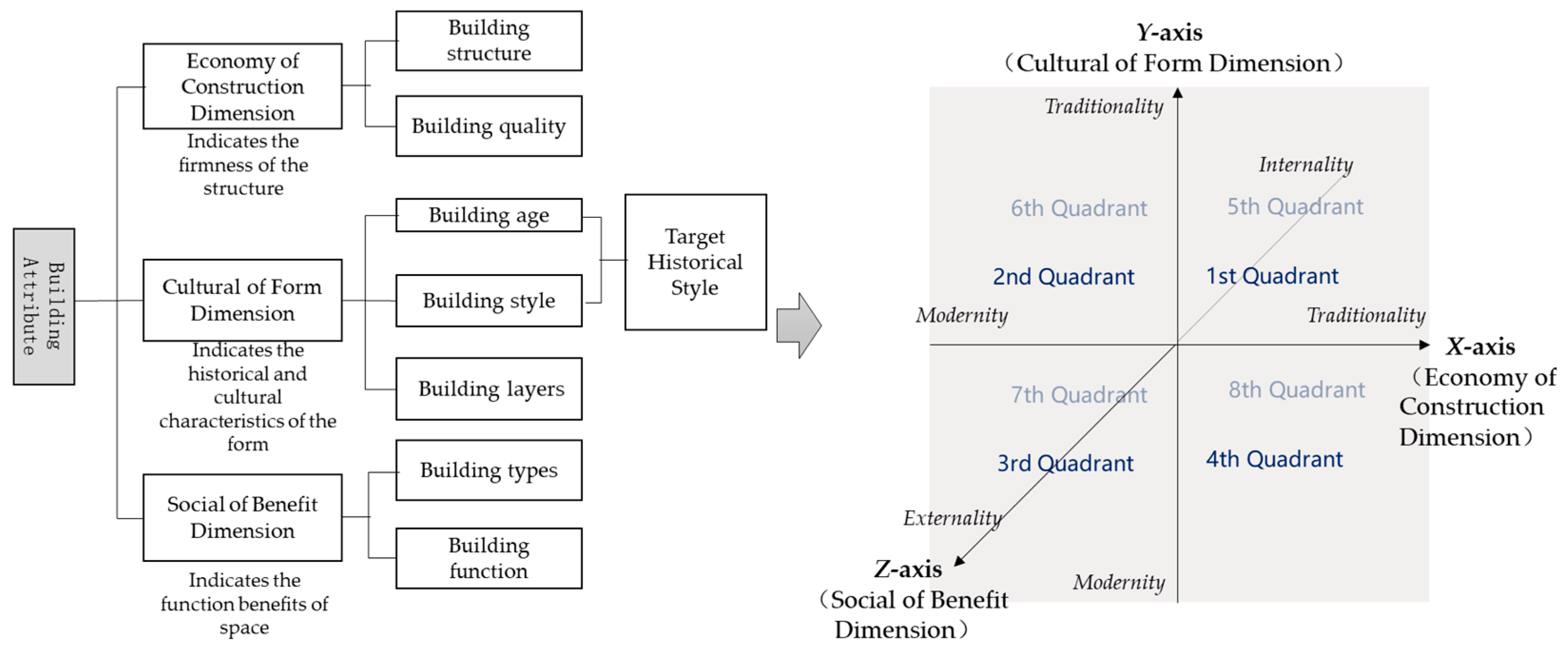
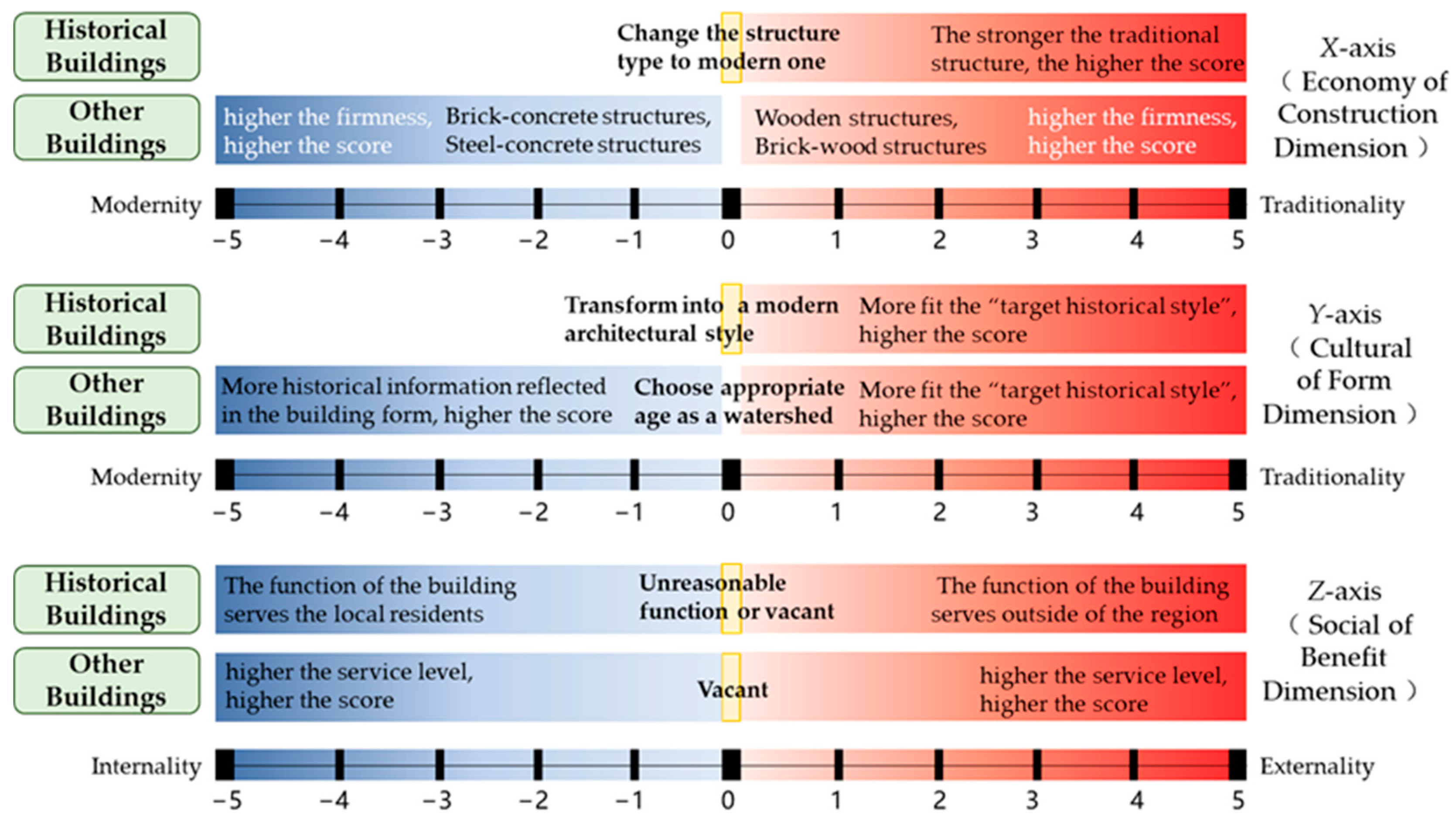
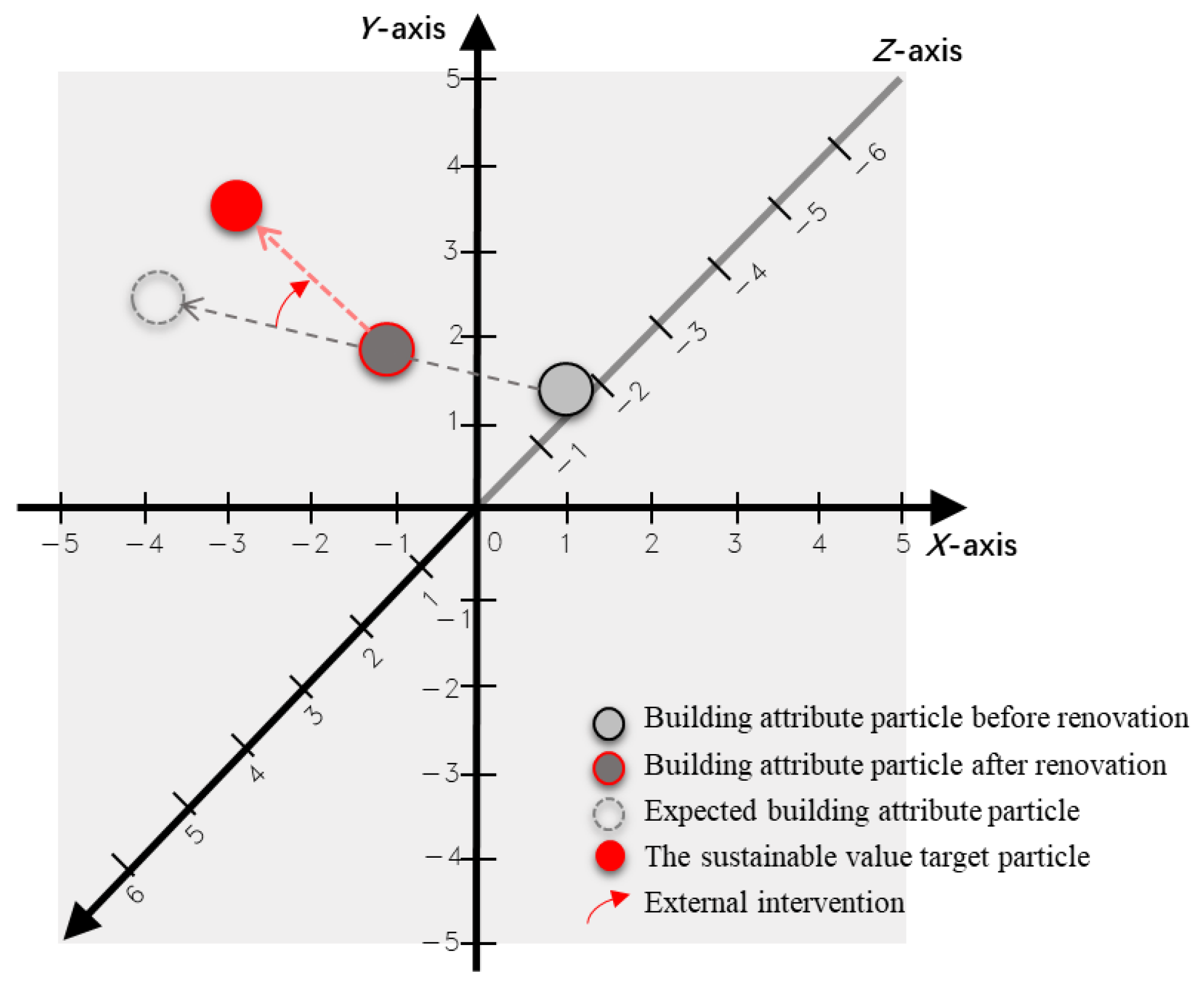
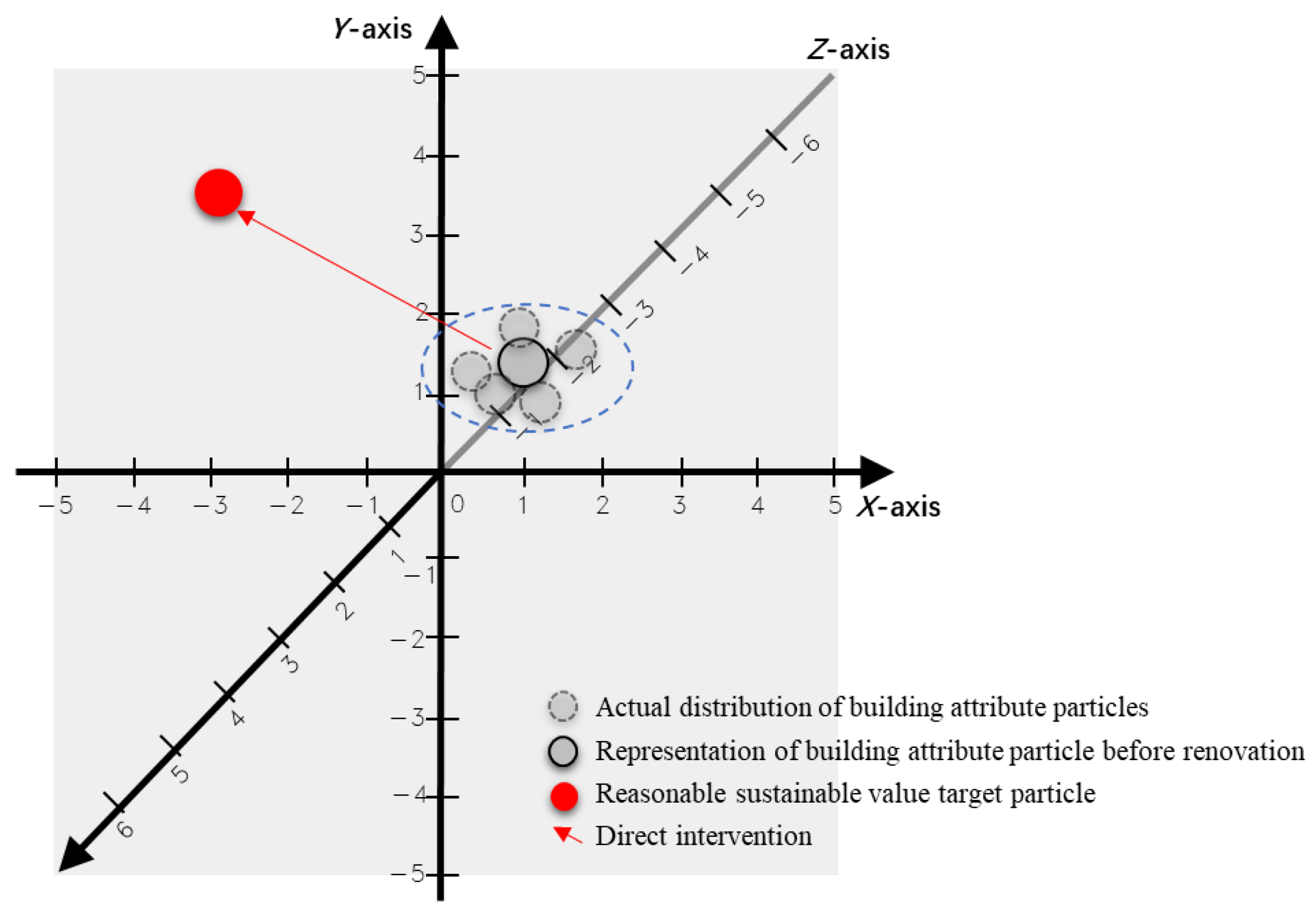
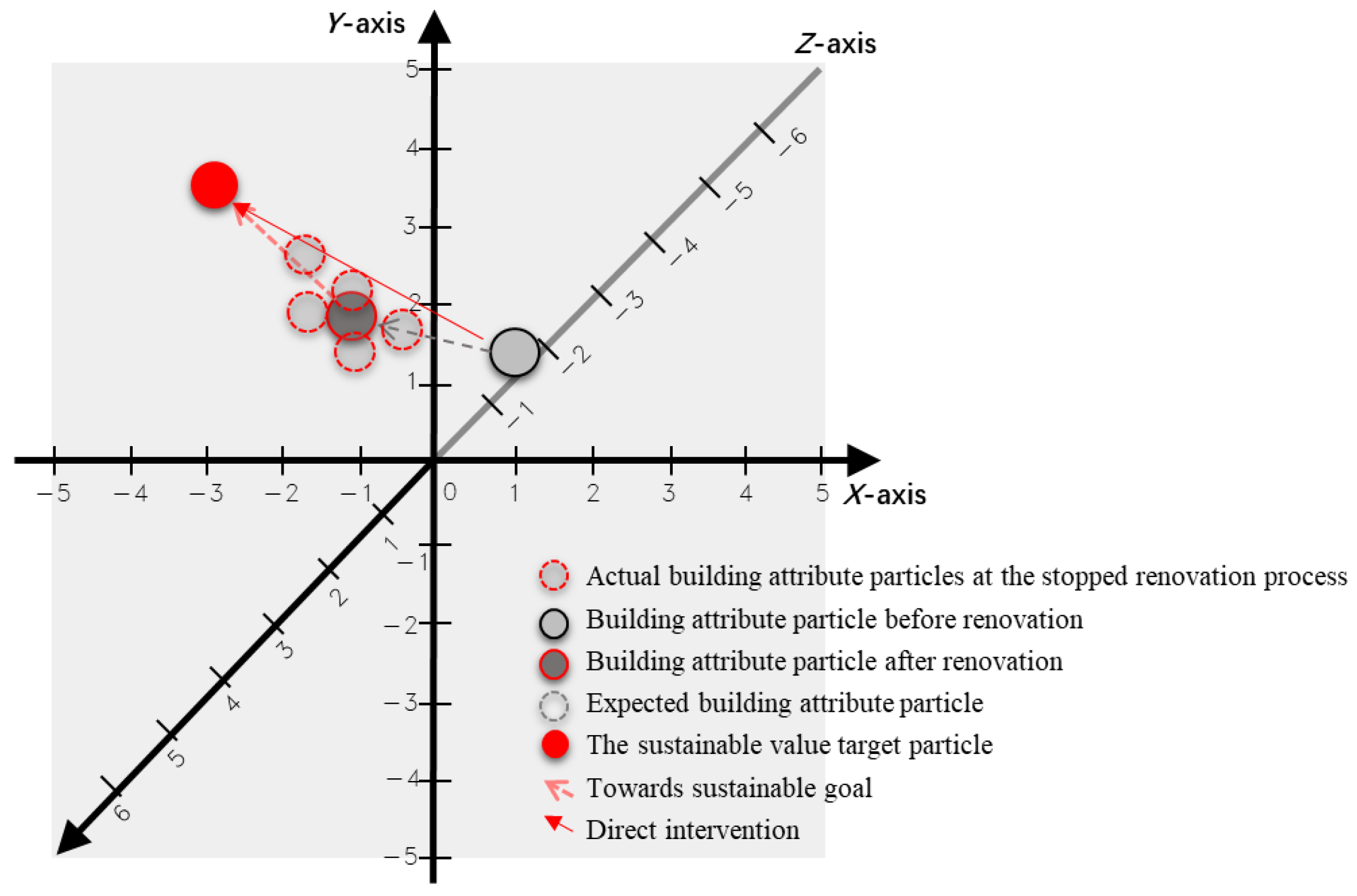
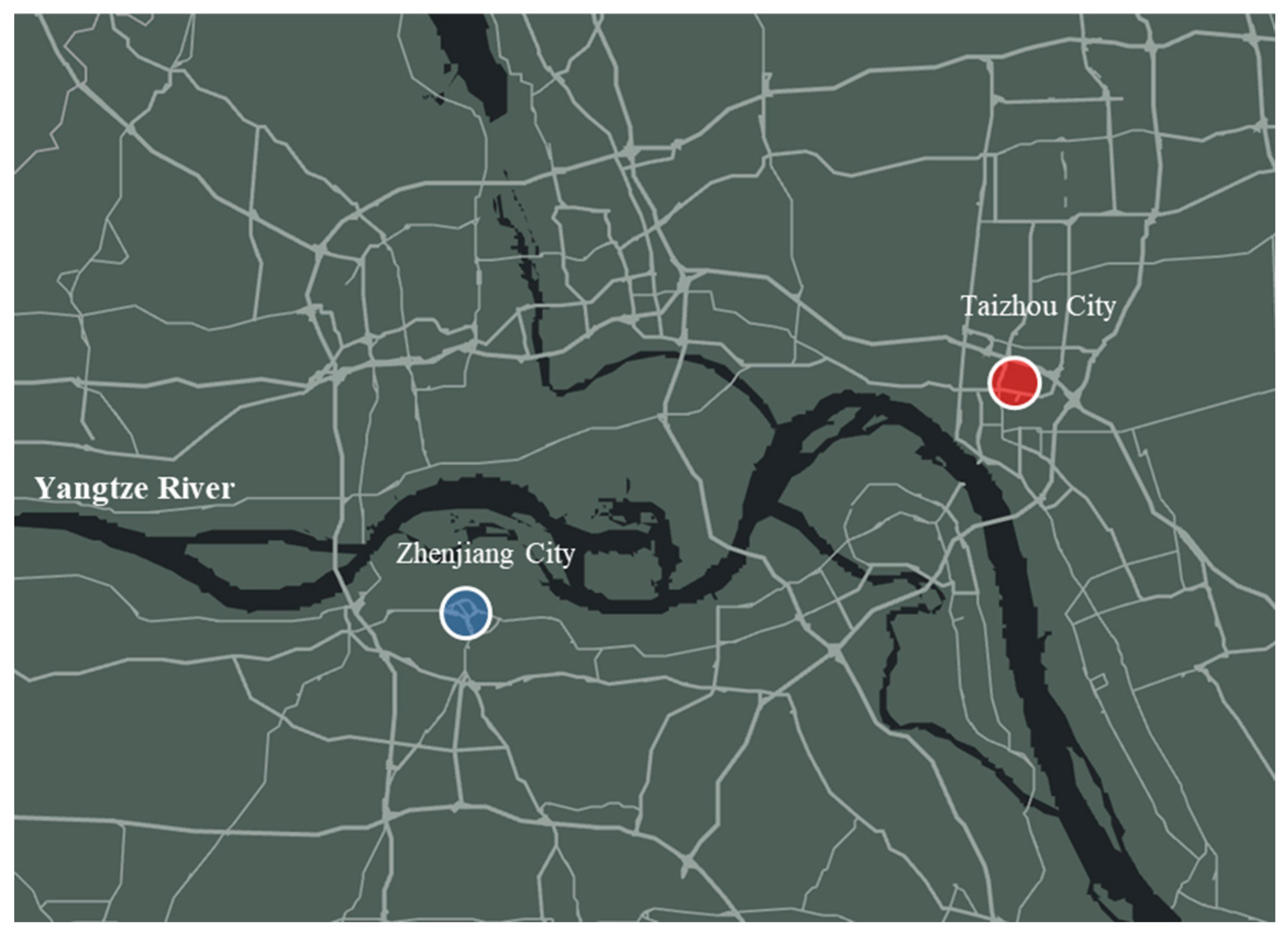
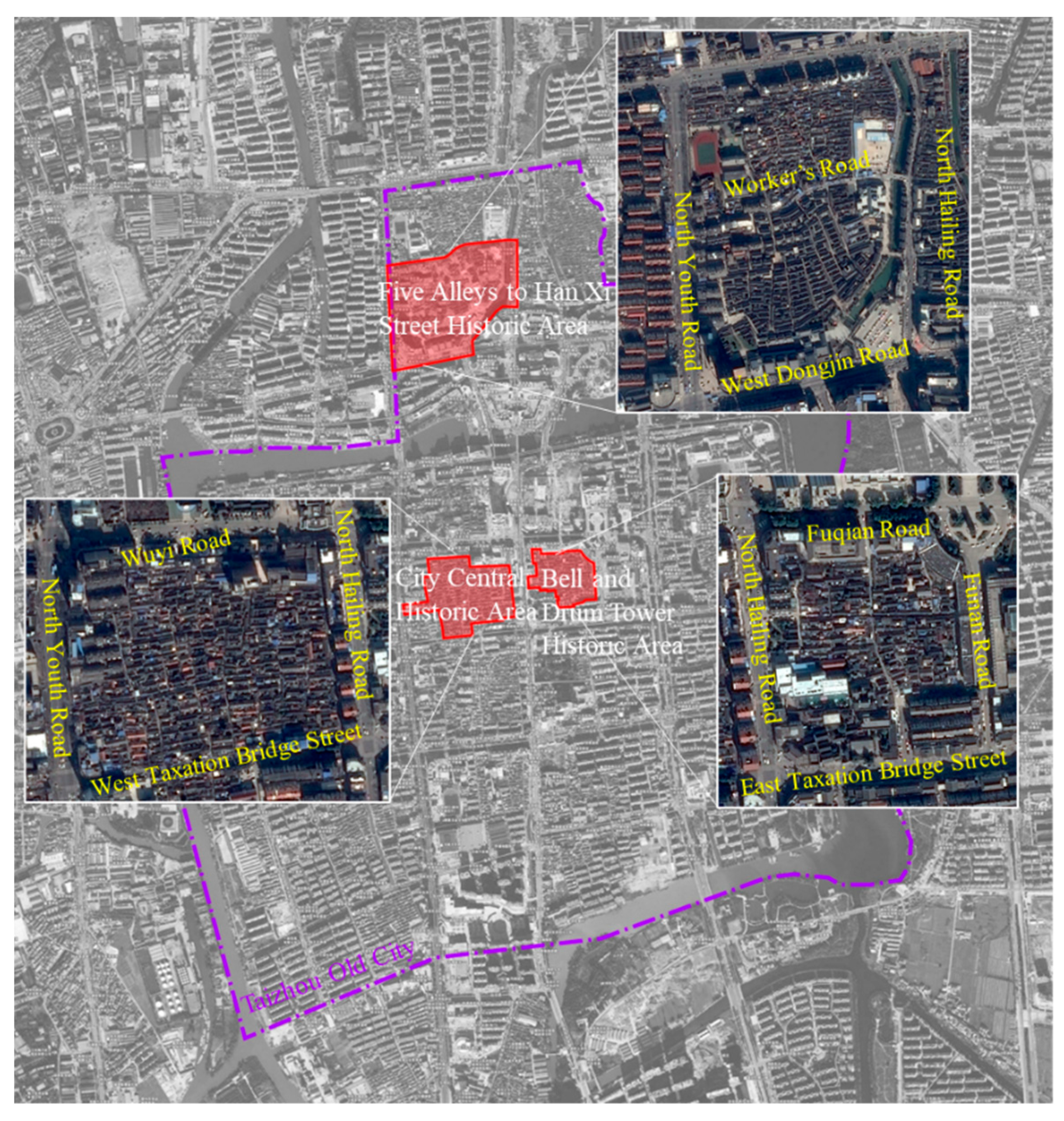
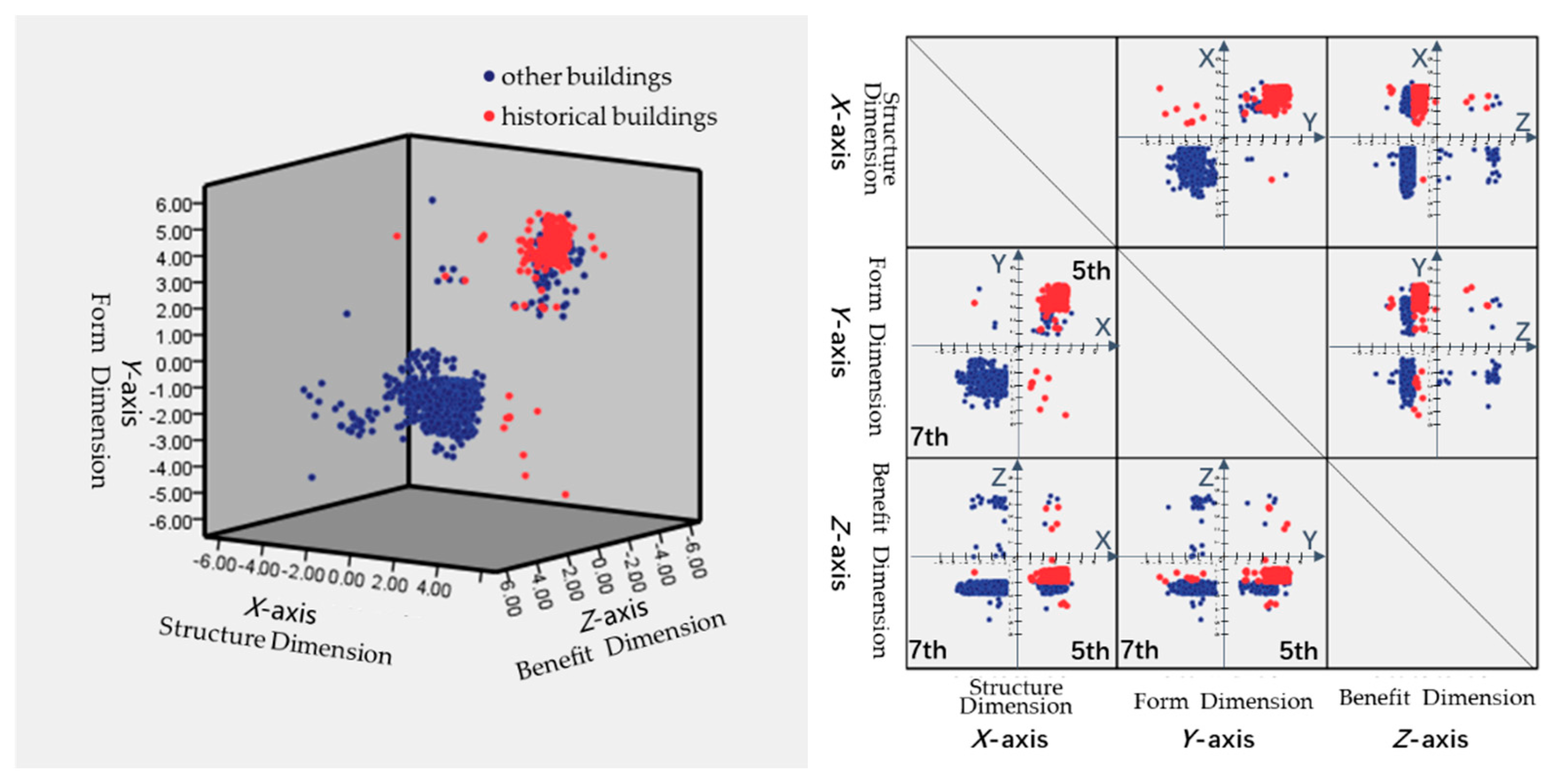
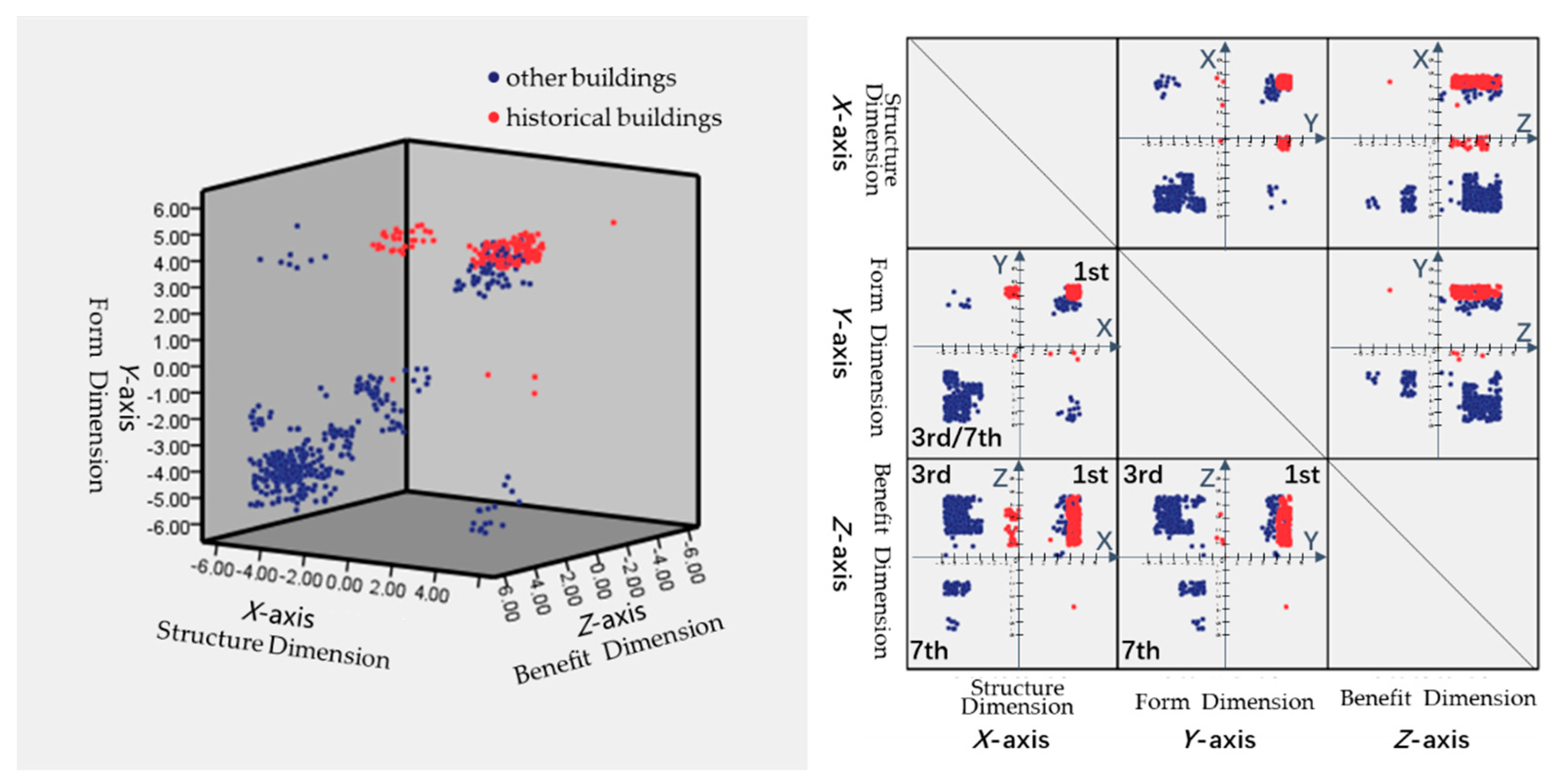
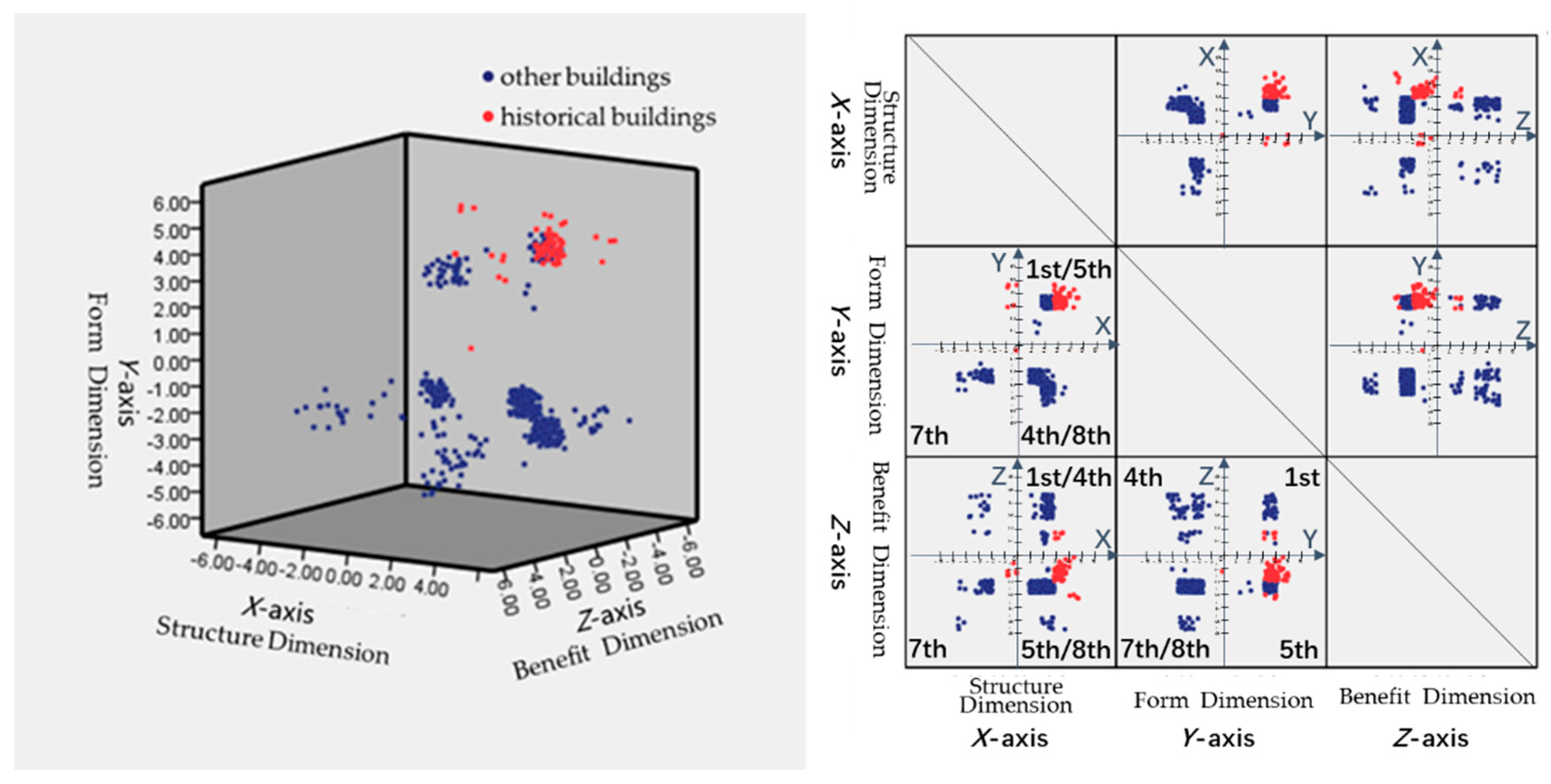
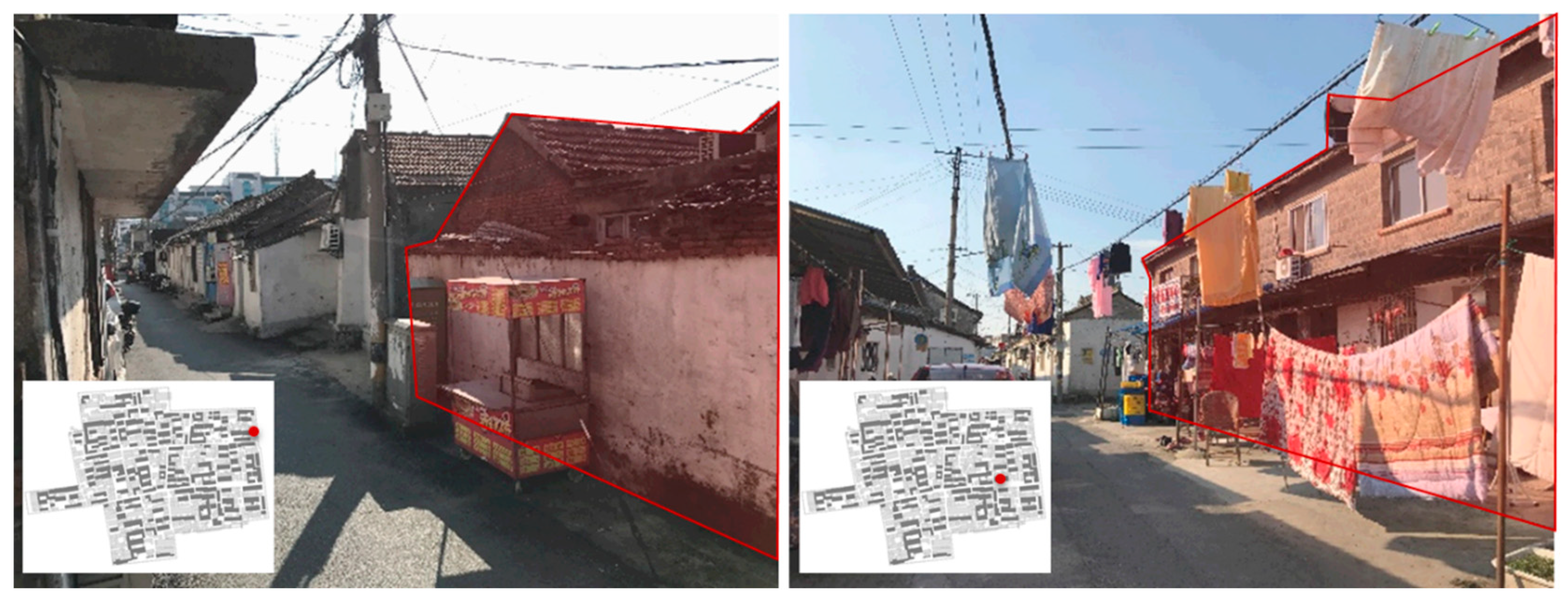
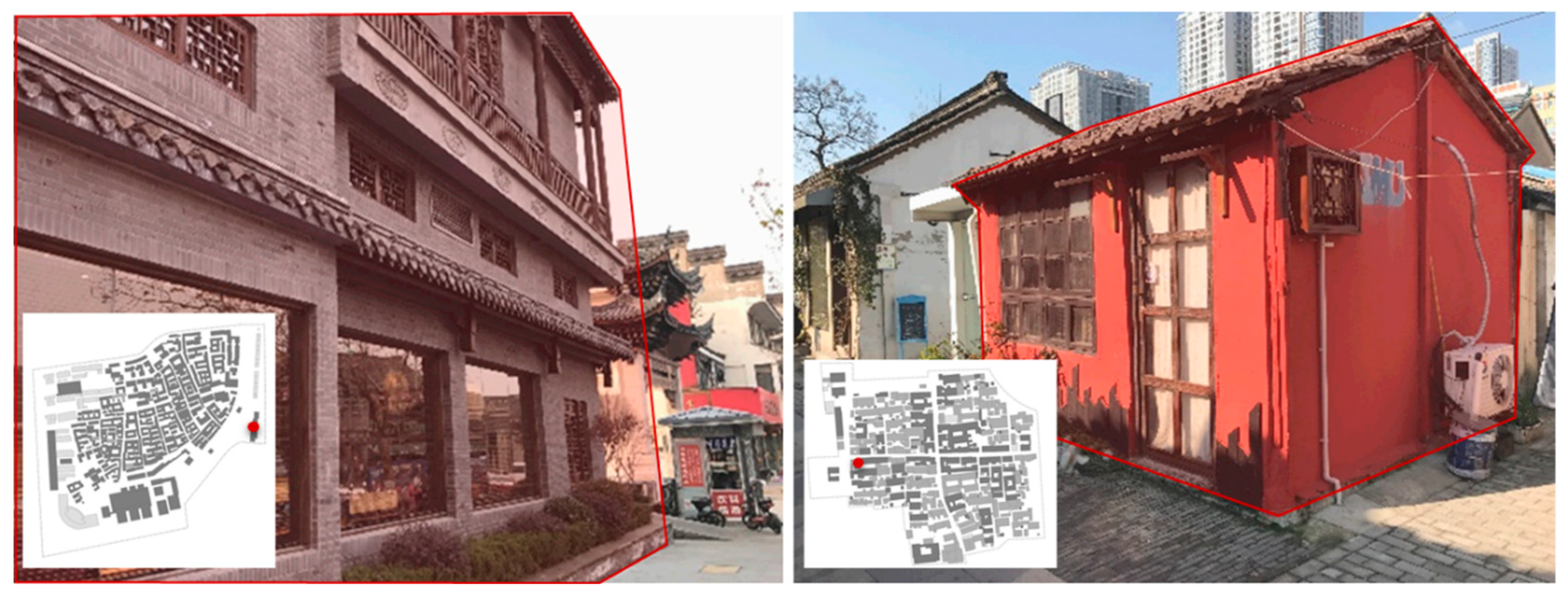

| Building Structure Graph | Building Quality Graph | Building Age Graph | Building Layers Graph | Building Types Graph |
|---|---|---|---|---|
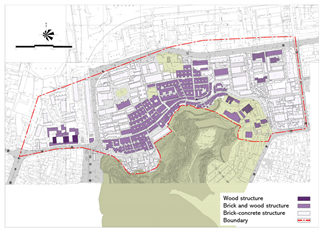 | 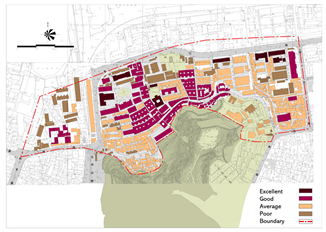 | 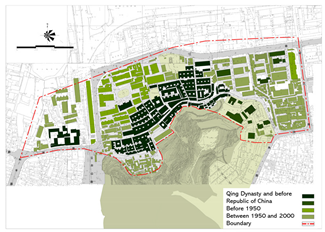 | 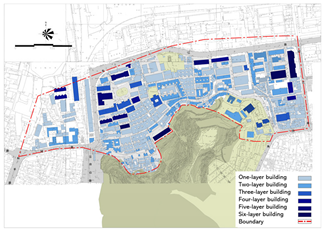 | 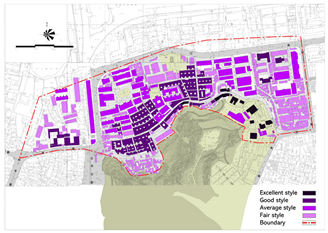 |
| Cluster Coordinate | Number of Points | Comparing Coordinate before Renovation | Target Coordinate Point | Building Type |
|---|---|---|---|---|
| (2, 0, −1) | 9 | Ignored | Ignored | Ignored |
| (4, 5, −1) | 153 | (≥3, ≥3, −1) | (5, 5, 5) | Authenticity type |
| (3, 4, −1) | 39 | |||
| (3, 4, −2) | 157 | |||
| (−1, −1, 5) | 31 | (<0, <0, 5) | (−5, −5, 5) | Deductive type |
| (−2, −2, −2) | 821 | (<0, <0, <0) | (−5, −5, −5) | Reproduction/reconstruction type |
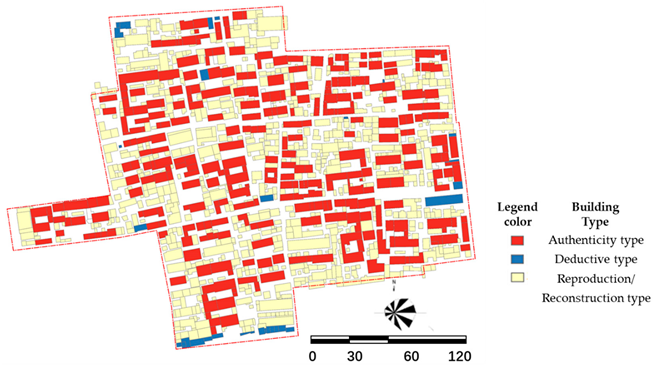 | ||||
| Cluster Coordinate | Number of Points | Coordinate before Renovation | Comparing Coordinate during Renovation | Target Coordinate Point | Building Type |
|---|---|---|---|---|---|
| (5, 5, −4) | 1 | Ignored | Ignored | Ignored | Ignored |
| (5, 5, 2) | 72 | (>0, >0, >0) | (3, 3, 3) | (5, 5, 5) | Authenticity type |
| (3, 5, 4) | 89 | ||||
| (−5, −2, −2) | 52 | (<0, <0, <0) | (−5, −3, −3) | (−5, −5, −5) | Reproduction type |
| (−4, 4, 4) | 8 | (<0, >0, >0) | (−3, 3, 3) | (−5, 5, 5) | Image-display |
| (5, 3, 4) | 91 | (>0, >0, >0) | (3, 3, 3) | (5, 5, 5) | Authenticity type |
| (−4, −4, 4) | 277 | (<0, <0, >0) | (−3, −3, 3) | (−5, −5, 5) | Deductive type |
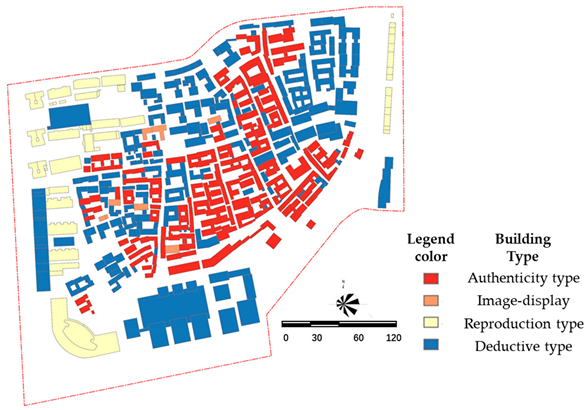 | |||||
| Cluster Coordinate | Number of Points | Coordinate before Renovation | Comparing Coordinate during Renovation | Target Coordinate Point | Building Type |
|---|---|---|---|---|---|
| (0, 5, −1) | 5 | Ignored | Ignored | Ignored | Ignored |
| (0, 0, −1) | 1 | Ignored | Ignored | Ignored | Ignored |
| (4, 4, 1) | 13 | (>0, >0, >0) | (3, 3, 1) | (5, 5, 5) | Authenticity type |
| (4, 4, −1) | 42 | (>0, >0, <0) | (3, 3, −1) | (5, 5, −5) | |
| (3, −3, −2) | 282 | (>0, <0, <0) | (3, −3, −3) | (5, −5, −5) | Image-display |
| (3, −3, 4) | 44 | (>0, <0, >0) | (3, −3, 3) | (5, −5, 5) | |
| (3, 4, 4) | 39 | (>0, >0, >0) | (3, 3, 3) | (5, 5, 5) | Authenticity type |
| (3, 4, −2) | 49 | (>0, >0, <0) | (3, 3, −3) | (5, 5, −5) | |
| (−2, −2, 4) | 17 | (<0, <0, >0) | (−3, −3, 3) | (−5, −5, 5) | Deductive type |
| (−2, −2, −2) | 60 | (<0, <0, <0) | (−3, −3, −3) | (−5, −5, −5) | Reproduction/reconstruction type |
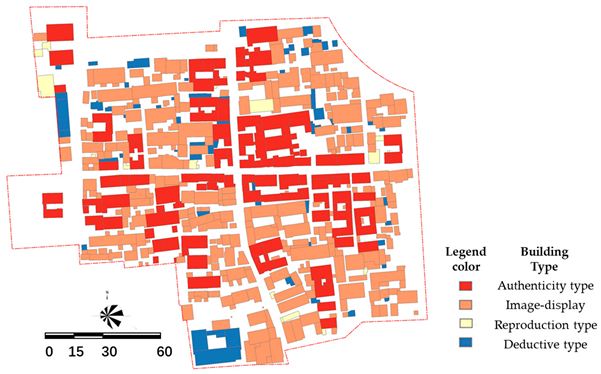 | |||||
| City Central Historic Area | Five Alleys to Han Xi Street Historic Area | Bell and Drum Tower Historic Area | ||||
|---|---|---|---|---|---|---|
| Authenticity type | 349 | 29.06% | 252 | 42.78% | 143 | 26.19% |
| Image-display | — | — | 8 | 1.36% | 326 | 59.71% |
| Reproduction type | 821 | 68.36% | 52 | 8.83% | 60 | 10.99% |
| Deductive type | 31 | 2.58% | 277 | 47.03% | 17 | 3.11% |
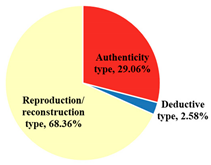 | 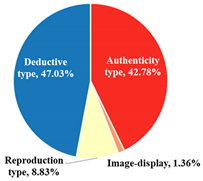 | 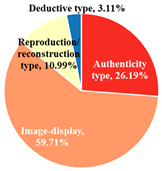 | ||||
Disclaimer/Publisher’s Note: The statements, opinions and data contained in all publications are solely those of the individual author(s) and contributor(s) and not of MDPI and/or the editor(s). MDPI and/or the editor(s) disclaim responsibility for any injury to people or property resulting from any ideas, methods, instructions or products referred to in the content. |
© 2024 by the authors. Licensee MDPI, Basel, Switzerland. This article is an open access article distributed under the terms and conditions of the Creative Commons Attribution (CC BY) license (https://creativecommons.org/licenses/by/4.0/).
Share and Cite
Xia, S.; Liu, B.; Wang, H. Building Categorization Strategy Guidance in the Historic Area Renovation Process. Sustainability 2024, 16, 1576. https://doi.org/10.3390/su16041576
Xia S, Liu B, Wang H. Building Categorization Strategy Guidance in the Historic Area Renovation Process. Sustainability. 2024; 16(4):1576. https://doi.org/10.3390/su16041576
Chicago/Turabian StyleXia, Sisi, Bomin Liu, and Haobing Wang. 2024. "Building Categorization Strategy Guidance in the Historic Area Renovation Process" Sustainability 16, no. 4: 1576. https://doi.org/10.3390/su16041576
APA StyleXia, S., Liu, B., & Wang, H. (2024). Building Categorization Strategy Guidance in the Historic Area Renovation Process. Sustainability, 16(4), 1576. https://doi.org/10.3390/su16041576






